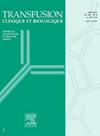Trend of blood donation including coronavirus pandemic: A nationwide cross-sectional study during 2017–2022 in Iran
IF 1.2
4区 医学
Q4 HEMATOLOGY
引用次数: 0
Abstract
Objectives
Blood transfusion is vital in modern medicine, saving lives in cases of hemoglobin disorders, transplants, major surgeries, trauma, and cancer treatments. This study primarily aimed to evaluate blood donation trends in Iran.
Materials and methods
A time trend ecological study with a nationwide cross-sectional design was conducted over a six-year period, from 2017 to 2022. The analysis focused on aggregate data obtained from the Iranian Blood Transfusion Organization (IBTO) database. We used trend analysis for proportions to examine the trend in blood donation and the chi-squared test to compare the characteristics of blood donations.
Results
A total of 12,352,275 blood donations were collected during the six- years study. The donation rate changed dramatically in 2020. Trend analysis revealed a significant decrease in donation rate (number of donations per 1000 population) from 25.78 in 2017 to 22.67 in 2020 (Slope = -0.001, ptrend < 0.000), followed by a significant increase to 26.25 in 2022 (Slope = 0.002, ptrend < 0.0001). There was a significant difference in gender, age groups, blood groups, and donation statuses (p < 0.0001) during the years. Age groups younger than 36 years showed a decrease from 46.35% in 2017 to 35.47% in 2022 (p < 0.0001).
Conclusion
Although a decrease in blood donations was observed due to factors such as the COVID-19 pandemic, donation rates have since returned to and even exceeded previous levels, confirming the success of the measures taken by IBTO. However, a decline in donations among individuals younger than 36 years old remains one of IBTO’s major concerns.
包括冠状病毒大流行在内的献血趋势:2017- 2022年伊朗全国横断面研究
目的:输血在现代医学中是至关重要的,在血红蛋白紊乱、移植、大手术、创伤和癌症治疗中可以挽救生命。这项研究的主要目的是评估伊朗的献血趋势。材料和方法:在2017年至2022年的6年时间里,采用全国范围的横断面设计进行了时间趋势生态学研究。分析的重点是从伊朗输血组织(IBTO)数据库获得的汇总数据。我们用比例趋势分析来检验献血的趋势,用卡方检验来比较献血的特征。结果:在六年的研究中,共收集了12,352,275份献血。2020年,捐赠率发生了巨大变化。趋势分析显示,捐赠率(每1000人的捐赠次数)从2017年的25.78次显著下降到2020年的22.67次(斜率= -0.001,ptrend < 0.000),随后在2022年显著上升到26.25次(斜率= 0.002,ptrend < 0.0001)。在性别、年龄组、血型和献血状况方面,各年份间存在显著差异(p < 0.0001)。36岁以下年龄组从2017年的46.35%下降到2022年的35.47% (p < 0.0001)。结论:尽管受新冠肺炎疫情等因素影响,献血人数有所减少,但献血率已恢复到甚至超过了之前的水平,证实了IBTO采取的措施是成功的。然而,36岁以下个人的捐款减少仍然是IBTO主要关注的问题之一。
本文章由计算机程序翻译,如有差异,请以英文原文为准。
求助全文
约1分钟内获得全文
求助全文
来源期刊
CiteScore
2.50
自引率
11.80%
发文量
234
审稿时长
36 days
期刊介绍:
Transfusion Clinique et Biologique, the official journal of the French Society of Blood Transfusion (SFTS):
- an aid to training, at a European level
- the only French journal indexed in the hematology and immunology sections of Current Contents
Transfusion Clinique et Biologique spans fundamental research and everyday practice, with articles coming from both sides. Articles, reviews, case reports, letters to the editor and editorials are published in 4 editions a year, in French or in English, covering all scientific and medical aspects of transfusion: immunology, hematology, infectious diseases, genetics, molecular biology, etc. And finally, a convivial cross-disciplinary section on training and information offers practical updates.
Readership:
"Transfusers" are many and various: anesthetists, biologists, hematologists, and blood-bank, ICU and mobile emergency specialists...

 求助内容:
求助内容: 应助结果提醒方式:
应助结果提醒方式:


